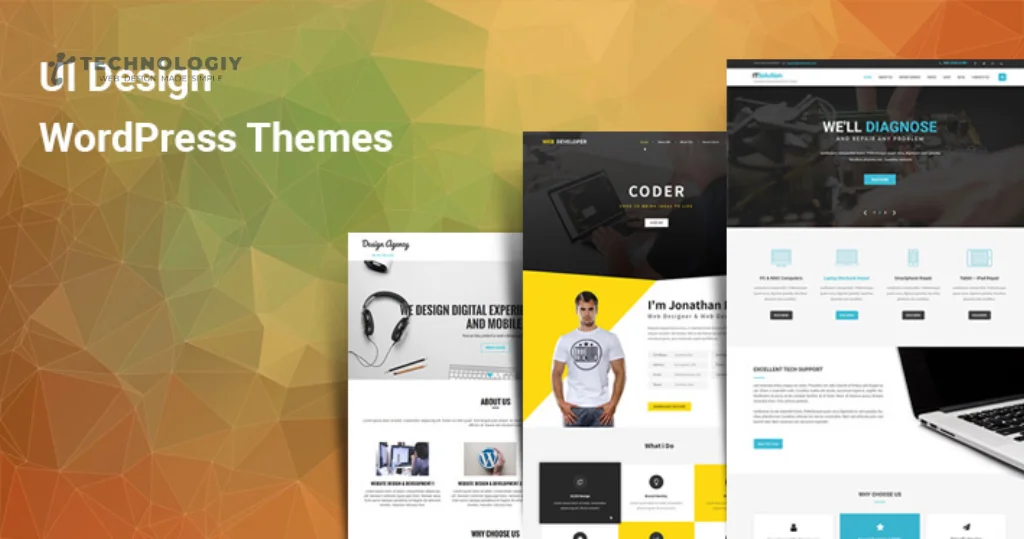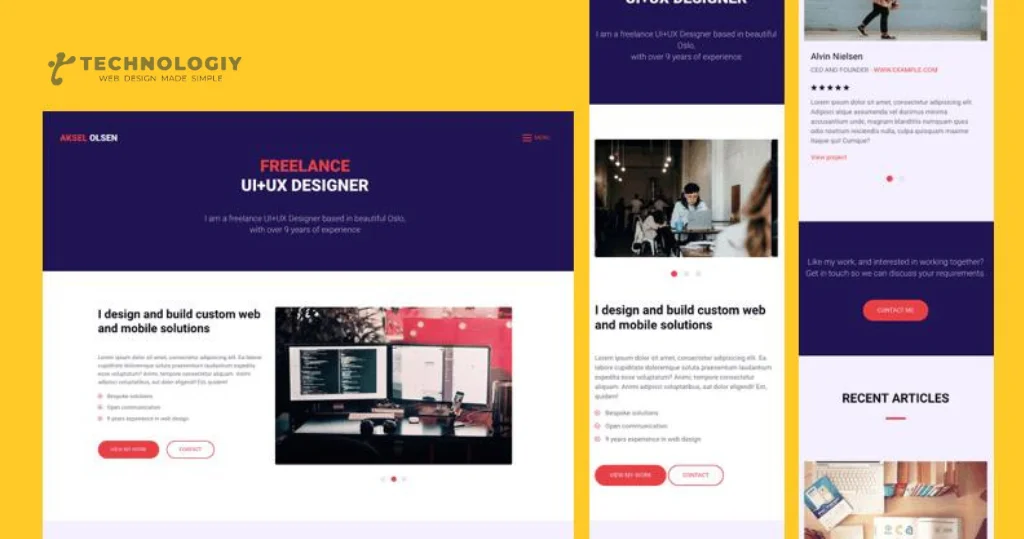Unlocking the Secrets of WordPress Theme UI/UX: A Beginner’s Guide Welcome to our beginner’s guide on unlocking the secrets of WordPress theme UI/UX! If you’re new to WordPress or looking to enhance the design and user experience of your website, you’ve come to the right place. In this guide, we’ll delve into the world of WordPress theme UI/UX, providing you with valuable insights and tips to create a visually stunning and user-friendly website.
Before we dive in, let’s quickly define what WordPress theme UI/UX means. UI stands for User Interface, which refers to the visual elements and design of a website. On the other hand, UX stands for User Experience, which focuses on how users interact with and navigate through a website. Both UI and UX play vital roles in creating an engaging and intuitive website.
Now, let’s unlock the secrets of WordPress theme UI/UX Design:
Choose the Right Theme:
The first step in enhancing your WordPress theme UI/UX is selecting the right theme. Look for a theme that aligns with your website’s purpose, appeals to your target audience, and offers a clean and intuitive design. Remember, a cluttered and confusing design can drive visitors away.
Customize Your Theme:
After selecting a theme, it’s time to personalize it. WordPress provides a range of customization options, allowing you to personalize your theme’s colors, fonts, layout, and more. Aim for a consistent and visually pleasing design throughout your website to create a seamless user experience.
Optimize for Mobile:
In today’s mobile-centric world, optimizing your WordPress theme for mobile devices is crucial. Ensure that your theme is responsive, meaning it adjusts seamlessly to different screen sizes and resolutions. This way, your visitors can enjoy a smooth browsing experience, whether they’re using a desktop, tablet, or smartphone.
Focus on Navigation:
Easy navigation is the key to a positive user experience. Make sure your WordPress theme offers clear and intuitive navigation menus, allowing visitors to find the information they need quickly. Using descriptive labels and organizing your content into logical categories can go a long way in enhancing user experience.
Pay Attention to Loading Speed:
Slow-loading websites can frustrate visitors and lead to higher bounce rates. Optimize your WordPress theme by compressing images, minifying CSS and JavaScript files, and utilizing caching plugins. These steps will help improve your website’s loading speed and provide a seamless browsing experience.

Incorporate Visual Elements:
Visual elements such as images, videos, and infographics can greatly enhance your WordPress theme UI/UX. They add visual appeal, break up text-heavy pages, and make your content more engaging. Ensure that your visual elements are high-quality, properly sized, and relevant to your content.
Test and Iterate:
Finally, don’t forget to test your WordPress theme UI/UX. Ask for feedback from friends, family, or even your website’s visitors. Please take their suggestions into consideration and implement any necessary improvements. Remember, UI/UX is an ongoing process, and continuously iterating and refining your website will lead to better user experiences.
By following these tips, you’ll be well on your way to unlocking the secrets of WordPress theme UI/UX. Remember to choose the right theme, customize it to align with your brand, optimize for mobile, focus on navigation, prioritize loading speed, incorporate visual elements, and test and iterate. With a user-friendly and visually stunning website, you’ll attract and retain visitors, boosting your online presence and achieving your website’s goals.
10 Essential UI/UX Features Every WordPress Theme Should Have Introduction:
Welcome to our friendly blog post where we’ll be discussing the top 10 essential WordPress theme UI/UX features that every WordPress theme should have. A well-designed user interface and a seamless user experience are crucial for the success of any website. So, whether you’re a web developer, a designer, or a website owner, this article is for you!
Responsive Design:
In the era of mobile browsing, it’s essential for your WordPress theme to have a responsive design. This means that your website should adapt and look great on any screen size, providing a consistent experience for your users.
Intuitive Navigation:
A user-friendly WordPress theme should have intuitive navigation that allows users to easily find what they’re looking for. Clear and well-structured menus, breadcrumbs, and search functionality are all important elements to consider.
Fast Loading Speed:
Nobody likes waiting for a website to load, so make sure your WordPress theme is optimized for speed. This includes optimizing images, minimizing HTTP requests, and leveraging caching techniques to deliver a snappy browsing experience.
Clean and Consistent Layout:
A visually appealing and consistent layout helps users navigate your website effortlessly. Use a grid-based approach, employ whitespace effectively, and ensure that your typography is easily readable across all devices.
Engaging Call-to-Actions:
Your WordPress theme should encourage users to take action. Whether it’s signing up for a newsletter, making a purchase, or simply exploring more content, well-placed and visually appealing call-to-action buttons are essential.
Accessibility Features:
Make sure your WordPress theme is inclusive and accessible to all users, including those with disabilities. This includes using appropriate color contrast, providing alternative text for images, and using semantic markup for screen readers.
Seamless Integration with Plugins:
WordPress offers a vast range of plugins to enhance your website’s functionality. Your theme should seamlessly integrate with popular plugins like contact forms, social media sharing, SEO optimization, and more.
Customization Options:
A good WordPress theme allows users to customize the look and feel of their website easily. This includes options for changing colors, fonts, layouts, and even adding custom CSS if needed.
Optimized for SEO:
To drive organic traffic to your website, it’s crucial for your WordPress theme to be optimized for search engines. Look for themes that have clean code, proper heading hierarchy, and schema markup to improve your website’s visibility in search engine results.
Regular Updates and Support:
Last but not least, choose a WordPress theme that is regularly updated and well-supported by the developer. This ensures compatibility with the latest WordPress version, security patches, and access to support when needed.
When it comes to WordPress theme UI/UX, these 10 essential features can help create a seamless and enjoyable experience for your website visitors. Remember, a well-designed and user-friendly theme not only enhances your website’s aesthetics but also improves user engagement and conversion rates. So, be sure to consider these features when choosing your next WordPress theme. Happy designing!
Exploring the Latest Trends in WordPress Theme UI/UX Design:
Are you a WordPress enthusiast looking to enhance the visual appeal and user experience of your website? Look no further! In this blog post, we will delve into the latest trends in WordPress theme UI/UX design that will not only make your website visually stunning but also ensure seamless navigation for your visitors.
Minimalism – Less is More:
In today’s fast-paced digital world, users appreciate websites that are clutter-free and easy to navigate. Minimalist WordPress themes are gaining popularity due to their clean and simple design elements. These themes focus on essential features and remove unnecessary distractions, resulting in a sleek and modern look.
Mobile-First Design – Responsive and Accessible:
With the majority of internet users accessing websites through their mobile devices, it is crucial to ensure that your WordPress theme is responsive and mobile-friendly. Mobile-first design emphasizes creating a seamless user experience on smartphones and tablets, ensuring that your website looks great and functions flawlessly across all devices.
Microinteractions – Delightful User Engagement:
Microinteractions are understated animations or visual signals designed to offer feedback and improve user engagement. They can be as simple as a button changing color when hovered over or a loading spinner that keeps users entertained while waiting for content to load. Integrating microinteractions into your WordPress theme can create a delightful user experience and make your website feel more interactive.
Customizable Layouts – Tailored to Your Brand:
Every website has unique requirements, and WordPress themes with customizable layouts allow you to create a design that aligns with your brand identity. From choosing the number of columns to arranging widgets and content blocks, these themes provide flexibility in creating a personalized website that stands out from the crowd.
Dark Mode – Eye-Catching and Modern:
Dark mode is an emerging trend in WordPress theme UI/UX design that offers a sleek and modern look to websites. By using a dark color scheme, websites not only appear visually striking but also reduce eye strain, especially in low-light conditions. WordPress themes with built-in dark mode options allow you to cater to users’ preferences and create a captivating browsing experience.
Typography – Communicate with Style:
Typography plays a crucial role in UI/UX design, as it helps convey your brand’s personality and enhances readability. Bold and unique fonts can make a significant impact on the overall aesthetic of your WordPress theme. Explore various font pairings to discover the ideal harmony between aesthetics and readability.
Accessibility – Inclusive Design for All:
Creating an inclusive user experience should be a top priority for any website owner. WordPress themes that prioritize accessibility consider factors such as color contrast, keyboard navigation, and screen reader compatibility. By making your website accessible to all users, you ensure that everyone can enjoy and engage with your content.
As the world of WordPress theme UI/UX design continues to evolve, it’s crucial to stay up-to-date with the latest trends. Implementing these trends into your website can help you create a visually appealing, user-friendly, and memorable experience for your visitors. So, why wait? Start exploring these trends and take your WordPress website to the next level!
Remember, the key to successful WordPress theme UI/UX design is finding the right WordPress theme that aligns with your brand and user expectations. With countless options available, take the time to research and choose a theme that provides the flexibility, customization, and functionality your website needs.
We hope this blog post has inspired you to consider the latest trends in WordPress theme UI/UX design. Happy designing!
